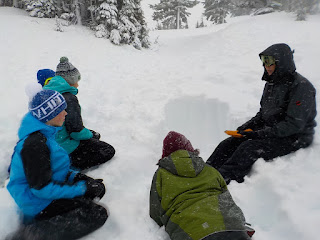The Red-Tailed Hawks met for another extended outing as part of their final Explorers Club season. In contrast to their last three outings, we would not be heading out into the backcountry, but rather to the Skagit Flats to observe some resident and migratory birds.
The Red-Tailed Hawks' last outing was up near the Mt Baker Ski Area where we got to experience winter weather in the mountains and practice our snow cave digging skills. Our birding outing brought us all the way back down to sea level, and specifically to the delta of the north fork of the Skagit river, many miles away from its own headwaters in the North Cascades.
The Skagit Flats area (including Wiley Slough, where we explored together) has been designated as a Western Hemisphere Shorebird Reserve Network (WHSRN) site because of its importance as habitat for resident and migratory birds. Additionally, this area has been recognized as important estuarine habitat for juvenile Chinook salmon and has received protection and habitat restoration because of this.
On our way down to the Skagit Flats, we took some time to talk about birds that we expected to see together. Our collective birding knowledge allowed us to accumulate a small list including some migratory waterfowl as well as some resident raptors and herons. We even saw a few geese and ducks from the bus on our drive down! We were prepared with plenty of binoculars and field guides to seek out these birds that we hoped to see as well as others that may be less familiar to us.
After parking the bus, we held an opening circle in the park shelter. The mentors passed around various bird props, beaks, skeletons and pictures as we held a discussion about bird migration and bird specific adaptations. We learned that the Skagit Flats is a very important stopping place for many species of migratory birds. Some of these birds are passing through to places farther south in the winter, while others come to spend their whole winter right here. For example, there is a population of Lesser Snow Geese that visit the Skagit Flats that breed exclusively on Wrangel Island in Russia!
 |
| Holding an opening circle |
The rest of our day was spent meandering through the estuary on the trails and doing our best to stay quiet and observe as many birds as we could. We saw some of our favorite residents including bald eagles, great blue herons, spotted towhees and a kingfisher. Additionally, we saw migratory birds including bufflehead and trumpeter swan. We observed the murmurations of a flock of unidentified shorebirds (click here for a beautiful video of this happening; its even shot in the Skagit valley!) and saw whole flocks of ducks scatter as a bald eagle soared above.
 |
| We enjoyed utilizing some bird blinds |
 |
| Evidence of a struggle |
 |
| Saw some of the salmonberry flowers of the year! |
We did make it all the way out to where the Skagit river met the Salish Sea and here we had an extended, hour-long, sit spot. Many Red-Tailed Hawks admitted that this was the time in which they saw the most bird activity because of the quiet and calm nature of the sit spot.
 |
| An awesome, expansive setting for our sit spot |
 |
| A Red-Tailed Hawk enjoys some solo time during his sit spot |
Towards the end of our day, the mentors helped the Red-Tailed Hawks revisit a concept that was introduced to them at their first outing (a campout at Welcome Pass Trailhead). This concept is that every person has their own unique relationship with nature. We have been asking the Red-Tailed Hawks to reflect on and examine their own relationship with nature this year. Today, we asked them how they wanted their relationship with nature to look like after the Red-Tailed Hawks graduate from Explorers Club this spring. It was noted that, in the absence of intention and action, our relationships with nature could begin to dissolve as we live in a society that does not value these relationships as much as some other facets of our lives. The mentors appreciated hearing some thoughts from the Red-Tailed Hawks about what their relationship currently looks like and how they would like to maintain and/or alter that relationship going forward.
 |
| Heading back from the delta to the bus |
Today, the weather was kind to us and we were able to explore the estuarine landscape while staying dry, and even enjoyed some prolonged sunbursts! In addition to this, we heard gratitude for spending time together, birds and taking a break from technology during our closing circle of thanks.
To see the rest of the photos from our day, click here!











































